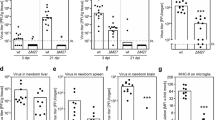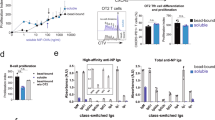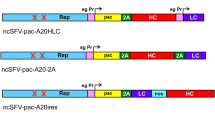Abstract
In C57BL mice of certain H–2 types, such as B10.A (H–2a), ecotropic leukemia virus has been shown to be transmitted by milk-borne infection. By selecting virus-positive and virus-negative B10.A mothers and foster-nursing the B10 (H–2b) newborn animals, four sub-lines of C57BL/10 mice have been obtained—B10.A V+, B10.A V−, B10 V+ and B10 V− (see Fig. 1 and ref. 1). Milk transmission of naturally prevalent B-tropic virus (V+ sub-lines) leads to a persistent infection of all the offspring over more than 8 generations2. We have studied the consequences of this kind of virus infection on the expression and immunogenicity of antigens coded for by the H–2 complex. This complex exerts a marked influence on oncogenesis by a variety of oncogenic RNA viruses3,4. The H–2K and H–2D loci restrict the specificity of virus-specific cytotoxic T lymphocytes5. In some instances, a direct physical association between H–2 and viral antigens has been demonstrated6–10. In our work, groups of B10.A V+ and B10.A V− mice were immunised with B10V+ and B10 V− lymphoid cells. Production of anti-H–2b antibodies was expected and observed in these sera. However, surprisingly, in the combination of B10 V+ donor and B10.A V− recipient, after prolonged hyperimmunisation, We obtained sera that reacted positively in the routine microlymphocytotoxicity test with B10.A V+ lymph-node cells, but not with B10.A V− cells. B10V− cells were able to absorb this antibody. Our preliminary conclusion is that the milk-transmitted virus, soon after birth, introduces a serologically detectable antigen which is recognised in association with H–2. The prerequisite for the formation of this kind of antibody is the immunisation of H–2 haplotype-different V− recipients with V+ donor cells.
This is a preview of subscription content, access via your institution
Access options
Subscribe to this journal
Receive 51 print issues and online access
$199.00 per year
only $3.90 per issue
Buy this article
- Purchase on Springer Link
- Instant access to full article PDF
Prices may be subject to local taxes which are calculated during checkout
Similar content being viewed by others
References
Melief, C. J. M., Louie, S. & Schwartz, R. S. J. natn. Cancer Inst. 55, 691–698 (1975).
Melief, C. J. M., Vlug, A., Barendsen, W., de Bruyne, C. & Molenaar, J. L. Advances in Comparative Leukemia Research 1977 (ed. Bentvelzen, A.) 78–83 (Elsevier, Amsterdam, 1978).
Lilly, F. & Pincus, T. Adv. Cancer Res. 17, 231–277 (1973).
Old, L. J. & Stockert, E. in Origins of Inbred Mice (ed. Morse, H. C.) 391–407 (Academic, New York, 1978).
Doherty, P. C., Blanden, R. V. & Zinkernagel, R. M. Transplant Rev. 29, 89–124 (1976).
Milner, R. J., Henning, R. & Edelman, G. M. Eur. J. Immun. 6, 603–607 (1976).
Bubbers, J. E. & Lilly, F. Nature 266, 458–459 (1977).
Blank, K. J. & Lilly, F. Nature 269, 808–809 (1977).
Kvist, S., Ostberg, L., Person, H., Philipson, L. & Peterson, P. A. Proc. natn. Acad. Sci. U.S.A. 75, 5674–5678 (1978).
Zarling, D. A., Kesket, I., Watson, A. & Bach, F. H. Scand. J. Immun. 8, 497–508 (1978).
Ivanyi, P. & de Greeve, P. in Origins of Inbred Mice (ed. Morse, H. C.) 633–655 (Academic, New York, 1978).
Ivanyi, P., van den Berg-Loonen, E. M. & de Greeve, P. Tissue Antigens 12, 32–38 (1978).
Moller, E. Transplantation 1, 165–173 (1963).
Datta, S. K., Tsichlis, P., Schwartz, R. S., Chattophadhyay, S. K. & Melief, C. J. M. Immunogenetics 7, 351–365 (1978).
Strand, M., Lilly, F. & August, J. T. Proc. natn Acad. Sci. U.S.A. 71, 3682–3686 (1974).
Author information
Authors and Affiliations
Rights and permissions
About this article
Cite this article
Ivanyi, P., Melief, C., van Mourik, P. et al. Lymphocytotoxic antibodies produced by H—2 allo-immunisation distinguish between MuLV-positive and -negative substrains of the same H-2 haplotype. Nature 282, 843–844 (1979). https://doi.org/10.1038/282843a0
Received:
Accepted:
Issue Date:
DOI: https://doi.org/10.1038/282843a0
This article is cited by
-
Immunization with syngeneic Sendai virus-infected cells induce no MHC-restricted antibodies but antibodies specific for H-2 class I determinants
Immunogenetics (1989)
-
H-2-specific antibodies induced by injection of syngeneic leukemia cells
Immunogenetics (1987)
-
Polymorphic and autoreactive H-2-specific monoclonal antibody isolated after injections of syngeneic sendai virus-coated lymphocytes
Immunogenetics (1986)
-
Anti-MHC immunity detected prior to intentional alloimmunization
Immunogenetics (1985)
-
Glucocorticoid-induced cleft palate genes in chromosome 17: Genetic linkage and mapping analyses
Immunogenetics (1984)
Comments
By submitting a comment you agree to abide by our Terms and Community Guidelines. If you find something abusive or that does not comply with our terms or guidelines please flag it as inappropriate.



